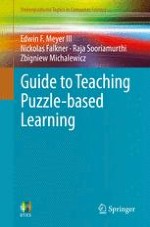
2014 | OriginalPaper | Buchkapitel
1. Motivation
verfasst von : Edwin F. Meyer III, Nickolas Falkner, Raja Sooriamurthi, Zbigniew Michalewicz
Erschienen in: Guide to Teaching Puzzle-based Learning
Verlag: Springer London
Aktivieren Sie unsere intelligente Suche, um passende Fachinhalte oder Patente zu finden.
Wählen Sie Textabschnitte aus um mit Künstlicher Intelligenz passenden Patente zu finden. powered by
Markieren Sie Textabschnitte, um KI-gestützt weitere passende Inhalte zu finden. powered by
Abstract
-
Given two eggs, for a 100-story building, what would be an optimal way to determine the highest floor, above which an egg would break if dropped?
-
Suppose you buy a shirt at a discount. Which is more beneficial to us: apply the discount first and then apply sales tax to the discounted amount or apply the sales tax first and then discount the taxed amount? What do stores do?
-
If you have a biased coin (say, comes up heads 70 % of the time and tails 30 %), is there a way to work out a fair, 50/50 toss?
-
A $10 gold coin is half the weight of a $20 gold coin. Which is worth more: a kilogram of $10 gold coins or half a kilogram of $20 gold coins?
-
A farmer sells 100 kg of mushrooms for $1 per kg. The mushrooms contain 99 % moisture. A buyer makes an offer to buy these mushrooms a week later for the same price. However, a week later, the mushrooms would have dried out to 98 % of moisture content. How much will the farmer lose if he accepts the offer?
-
If you heat a metal washer with a hole in the middle, what happens to the size of the hole?